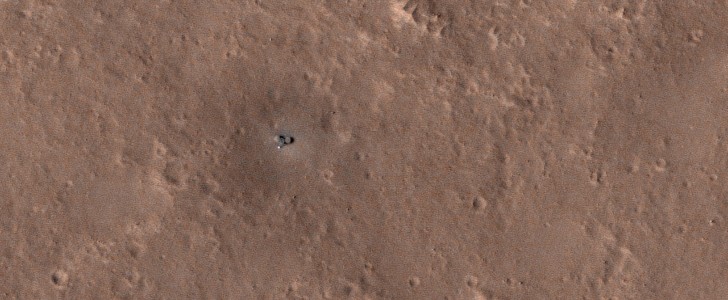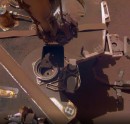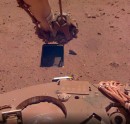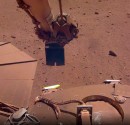Mars is known for being a dusty planet. Martian dust storms are a common occurrence, especially during spring and summer. They sometimes can be so large that they spread across massive regions, blocking the sunlight – and that's clearly not a good thing for NASA's solar-powered spacecraft.
In 2018, NASA's InSight lander arrived on Mars to examine the planet's interior, including its crust, mantle, and core. Although the spacecraft achieved its science objectives, NASA extended the mission through December 2022.
But to peek into the Red Planet's core requires energy, something that the spacecraft gets with the help of its two 7-foot (2.2-meter) solar panels. At the beginning of the year, a large sand storm hit the region where InSight is located, suffocating the poor spacecraft.
The team behind InSight commanded the lander to enter safe mode and shut down all non-essential systems in order to preserve its energy. When the storm hit, the lander already had its panels partially covered in dust.
The spacecraft exited safe mode once the air was clearer, but the effects could be observed from space. On March 9th, NASA's Mars Reconnaissance Orbiter snapped an image of InSight while orbiting the planet at a 170-mile (274-km) altitude.
The picture shows the lander almost becoming one with the landscape – that's how much dust it has accumulated. It's a stark contrast to the images taken after it landed in 2018. Moreover, the blast zone that formed during the landing has also been partially covered up, and it now resembles its pre-landing state.
But even if the spacecraft appears to be choking on reddish Martian dust, "the solar panels of NASA's InSight lander are producing almost as much power as they did before the storm. That power level should enable the lander to continue science operations into the summer", said NASA in a statement back in February, after the storm passed.
Who knows, maybe the lander will get lucky, and a blast of wind will blow away some of the accumulated dust.
But to peek into the Red Planet's core requires energy, something that the spacecraft gets with the help of its two 7-foot (2.2-meter) solar panels. At the beginning of the year, a large sand storm hit the region where InSight is located, suffocating the poor spacecraft.
The team behind InSight commanded the lander to enter safe mode and shut down all non-essential systems in order to preserve its energy. When the storm hit, the lander already had its panels partially covered in dust.
The spacecraft exited safe mode once the air was clearer, but the effects could be observed from space. On March 9th, NASA's Mars Reconnaissance Orbiter snapped an image of InSight while orbiting the planet at a 170-mile (274-km) altitude.
The picture shows the lander almost becoming one with the landscape – that's how much dust it has accumulated. It's a stark contrast to the images taken after it landed in 2018. Moreover, the blast zone that formed during the landing has also been partially covered up, and it now resembles its pre-landing state.
But even if the spacecraft appears to be choking on reddish Martian dust, "the solar panels of NASA's InSight lander are producing almost as much power as they did before the storm. That power level should enable the lander to continue science operations into the summer", said NASA in a statement back in February, after the storm passed.
Who knows, maybe the lander will get lucky, and a blast of wind will blow away some of the accumulated dust.








